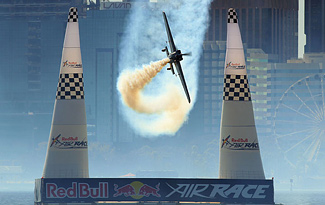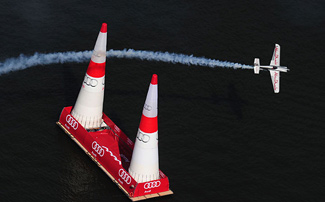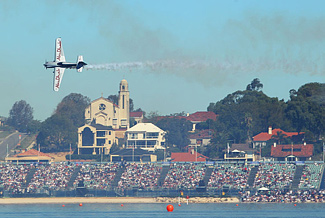HD Gets Its Wings

Hannes Arch of Austria in action during the Red Bull Air Race Day on April 18, 2010 in Perth, Australia. Photo Credit: Paul Kane/Getty Images for Red Bull Air Race
WINDSOR, ONTARIO
This is a young sport unlike any other, one that requires sharp concentration, extreme maneuverability and exceptional athletic prowess. And that's just what's required of the pilots.
The real stars of the sport known as extreme air racing may just be the planes themselves—a fleet of shiny propeller-driven planes that flip, barrel roll and weave through floating pylons, racing against the clock and against overwhelming G-forces. And they do it all at 230 mph just a few feet above the ground.
Over the last five years, the Red Bull Air Race World Championship has evolved to become one of the better-known extreme air races in the world, giving a growing number of fans a matchless look at the possibilities inherent in aerial motor sports.
In 2010, the event will include eight races set in locations across the globe. Starting with Abu Dhabi in March, the race will continue to Australia, Rio de Janeiro and Budapest, among others, and then, for the first time, to New York City. Since the Red Bull Air Race's inception in 2005, the format has evolved, with 15 pilots now competing in timed races to earn a championship title at the end of each race.
In 2009, more than 270 million viewers followed the Red Bull Air Race on television. So to showcase each race to the millions of fans on-site and watching at home, the Red Bull team sets up an intricate production facility at each of the race locations. A team of more than 350 people brings the physical infrastructure to each new locale, including hangers, the race tower and inflatable pylons known as Air Gates that are tough enough to be rammed or even punctured without damaging the plane, and then re-inflated while still in the air.
"It's extremely exciting but at the same time extremely challenging to find the best and most creative way to coordinate all these massive and complex transport flows," said Christof Reichl, logistics manager for the Red Bull Air Race World Championship. "We're always looking for ways to improve logistics. The race gets bigger each year and so do the challenges."

Hannes Arch of Austria in action during the Red Bull Air Race Day on April 17, 2010 in Perth, Australia. Photo Credit: Cameron Spencer/Getty Images for Red Bull Air RaceNEW INNOVATIONS
The demands are likewise enormous when it comes to setting up the technical broadcast infrastructure of such a production.
As it has for the last several years, the Red Bull Air Race has turned broadcast production responsibility over to the German firm Riedel Communications, which provides a mix of intercom, fiber connectivity and audio systems in an effort to integrate both HD video and audio signals as well as wireless and wired digital intercom systems.
The setup for the 2010 season has been further expanded, with this year's race being broadcast entirely in HD, including the high-def images that are captured from the race planes' onboard cameras, said Andreas Hilmer, director of marketing and communications for Riedel. "Our expertise in delivering the crystal clear images from the on-board cameras is unrivalled and helped the Red Bull Air Race win an Emmy Award for sports television broadcasting, and in getting another two nominations for this year," he said.
In addition to the onboard HD cameras and wireless video links, Riedel is also responsible for the fiber signal transport for all HD video, audio, data and intercom signals via MediorNet fiber nodes, with audio signals interfaced via the RockNet audio distribution network; high-bandwidth radio links between the event locations and airport; intercom setup; race control desks setup; digital radio network infrastructure; and related IT services.
As it has in year's past, the signal distribution infrastructure for all the video, audio, communications and data during the Air Race plays a key role. Since the 2009 season, the infrastructure has been based on the Riedel MediorNet fiber signal transport solution that includes routing and signal processing. Since the communications and video signal infrastructure often covers a large area, the MediorNet has been ideal in handling both point-to-point and multipoint routing, Hilmer said.
"The unique aspect of the Red Bull Air Race is that all signals of the production are integrated into one single real-time fiber network with Riedel MediorNet combining HD/SD video, audio, intercom and control data," said Yung-min Lee, Riedel project manager for the Red Bull Air Race.

Since the Red Bull Air Race's inception in 2005, the format has evolved, with 15 pilots now competing in timed races to earn a championship title at the end of each race. Photo credit: Mike Hewitt/Getty Images for Red Bull Air Race For on-site production, the Air Race has tasked the German production company SIVision with providing a 54-foot mobile production truck with a mix of Sony HDC-1500 HD cameras and Sony HDC-3300 HD Super Motion cameras, Canon lenses, a Sony MVS-8000G production switcher, Harris Platinum routers, a Riedel Artist Digital Matrix intercom and a production wall that includes Sony LMD-2450W HD production monitors.
WIRELESS TRANSPORT
The duties of managing the wireless video transport fell to Carlsbad, Calif.-based Global Microwave Systems, a subsidiary of Cobham, which supplied the competition with a series of HD COFDM links. A technology known for its robust capabilities even in non-line-of-sight scenarios, the COFDM-based equipment is being used to link full-motion HD video from two on-plane cameras to the video production facilities on the ground. With a mini camera in the cockpit aimed directly at the pilot and one shooting from the tail of the plane, the Messenger II series of wireless transport HD gear has been designed to send the images of a spinning, looping pilot and his plane down to receive sites on the ground for display on a giant video wall as well as for use in broadcast. The Air Race is using the M2T transmitter, MSR receiver and M2D decoder from the company.
"In the past, HD cameras weren't small enough, and there were a few HD encoding problems," said Jimi Henderson, sales and marketing manager for Cobham. "This equipment is specially designed to withstand high shock and G-forces… and were designed with a small size and power efficiency in mind."
As of press time, the Air Race had stopped in Perth, Australia, and Rio de Janero, and was next scheduled to shuttle off to Windsor, Ontario, in June, where the racecourse will be set up over the blue waters of the Detroit River.
Get the TV Tech Newsletter
The professional video industry's #1 source for news, trends and product and tech information. Sign up below.
Susan Ashworth is the former editor of TV Technology. In addition to her work covering the broadcast television industry, she has served as editor of two housing finance magazines and written about topics as varied as education, radio, chess, music and sports. Outside of her life as a writer, she recently served as president of a local nonprofit organization supporting girls in baseball.

